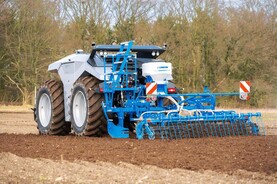Self-propelled silage harvesters are among the most powerful agricultural machines in use, with engines that pump out more than 500hp and operate at faster field speeds than combine harvesters. These perform multiple functions that require regular driver monitoring.
These machines use wider cutting-edge technology and know-how than that used to drive a car. The working environment in the field is also more challenging.
The driver terminal must be able to process information from more than 30 components on the machine. These include the engine, metal detection or the grinding device, all within fractions of a second.
The driver terminal also includes different alert and diagnostic systems.
Krone has installed all these features into a new touchscreen terminal in the cab of its flagship forage harvester, Big X 480/580. Engineers at Krone have worked with the Qt software library during the development stage to create the design.
Krone claims to have set new standards in user-friendliness and flexibility, primarily because of the touchscreen technology’s new functionality. Terminals with integrated touchscreen technology have been increasingly requested by harvester drivers, according to Krone.
With the beginning of the smartphone era, however, Krone has admitted to having difficulties in keeping up to date with the rapidly changing market. The company feels that the new control terminal brings it ahead of its competitors when it comes to the operational handling in the driver’s cab.
The new driver terminal serves as an operational hub connecting the driver to his machine. The driver of the Krone Big X 480/580 forage harvester has access to more than 30 functions in the cab. These can now be controlled and adjusted at a constant pace. The terminal receives up to 1,000 signals per second, which appear on the monitor after being processed.
Sensors
Touchscreen technology in such a large machine cannot be compared to that of a smartphone, because its sensors do not require such high levels of sensitivity, and therefore must only react to significant pressure.
The systems were developed by software company UI-Designer, Alexander Bücken, the Krone Software-Development team and a developer at software provider e-GITS.
The system can perform more than 80 different tasks and has a field and a road mode. It has a day and night mode with additional back-lighting for night use. The unit is available in four languages – German, English, French and Italian.
The system provides for seasonal and crop settings. It has a number of control functions for processing area, diesel consumption and distance and also for invoicing customers.
Since spring 2014, The Big X 480/580 has been running successfully with the new and improved terminal technology. Krone also plans to continue to use the technology for further forage harvester developments.
Tractor engine emission timelines
We have had some queries on the timelines for the various levels of engine emissions for agricultural tractors.
Stage IIIB or Tier 4 Interim regulations took effect in January 2011 for engines above 173hp (129kW) and in January 2012 for engines at or below 173hp (129kW) which involved the fitting of Selective Catalytic Reduction (SCR) systems with the use of AdBlue fuel additive in many new tractors since.
The new Stage III and IV standards were adopted for tractors in February 2005. Stage III standards are further sub-divided into two categories, Stage IIIA and IIIB. The former came into force between 2006 and 2008, while the latter was introduced between 2011 and 2012, depending on engine power. Stage IV regulations, which only apply to non-road vehicles with a net engine power exceeding 74hp (56kW), came into force in 2014.
Categories
Tractors are classified under EU regulations by a series of letters starting with T1 and ending in T5. Crawler or tracked tractors are classified in a separate heading with the letter C.
A limited number of categories are excluded from the move to the Stage IV engine emission level – T2, T4.1 and C2. These are typically specialist tractors and very few, if any, appear on the Irish market. These latter tractors have an additional three years before the Stage IV regulations come into force.
Tractor manufacturers can avail of a level of flexibility in the numbers of tractors they can supply with the older engine technology. This is called the Flexibility Scheme. Tractors availing of the Flexibility Scheme must have the word “Flexibility” marked clearly on the manufacturer plate.
For the Stage IV move this is limited to 20% of tractors produced or it can be a fixed number of tractors made available for sale in the EU. For the farmer, these flexibility tractors should be keener priced and may not have to include some technology that adds to running costs.
Stage V regulations
The European Commission is looking at the next stage in engine emission limits for non-road machinery such as tractors called the Stage V level. This is being discussed with the tractor industry and farming interests. It is believed it could be adopted by the Commission by the end of 2015 and introduced between 2019 and 2021.
It is understood the aim of the new Stage V legislation is the incorporation of non-road engine classes such as those used in all-terrain vehicles (ATVs), side-by-side vehicles (UTVs), and handheld machinery, such as walk-behind power harrows. It appears this Stage V legislation will apply to all non-road machinery from handheld machines to large generator sets.
It is believed the Stage V emission limits will be closer aligned to current on-road emissions limits. New areas of focus include the use of particulate number (PN) levels for engines between 19 and 560 kW, which will further extend the use of diesel particulate filter (DPF) technology and is already used in on-road emission legislation.






 This is a subscriber-only article
This is a subscriber-only article












SHARING OPTIONS: